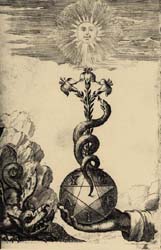Unpacking and publishing the Phaistos Disk since 1993
HOME | PREVIOUS | NEXT | SITEMAP
- The higher world between the Hebdomad and the Ennead, also called the Thirteenth Aeon. The Ogdoad is the eighth heaven and has an interior realm. Sophia dwells there, as does Ialdabaoth. The fixed stars above all the seven heavens of the planets were considered to be the Ogdoad, also defined as one of the three planes of the lower world, itself the highest, but lying immediately below the world of light, which is the dwelling of the Mother who generates the spiritual substance. The idea of the Ogdoad (a Greek word) may be of Egyptian origin. Hermes Trismegistus states that adepts will enter into immortality and come to understand the Ogdoad, which reveals, in its turn, the Ennead.
The Ogdoad in said to be the destination of souls after death. The material body is abandoned, and the soul re-ascends the planetary spheres, shedding astral bodies and becoming lighter and lighter, finally attaining to the Ogdoad to become one of its powers. There, the soul enters into God and merges.
In Gospel of the Egyptians, there are three powers which emerged from the invisible great spirit as emanations; the Father, Mother, and Son. Then three Ogdoads formed themselves. The emanations continued, one after another, producing Mirothea, Adamas-Light, Harmozel, Oroiael, Daueithe, Heleleth, Grace, Sensibility, Comprehension, Reflection, Gamaliel, Gabriel, Samlo, Abrasax, Memory, Charity, Peace, and Life Everlasting.
- A Gnostic sect which taught that the creation of the world came from the cosmic egg (possibly the Philosopher's Egg of the alchemists of the later centuries). The Diagram was their central text. They believed in Anthropos, the gigantic primordial man in the Universe. The Ophites believed that each part of the body has its correspondence in a larger physical reality, the geography of the Mediterranean world. They thought the God of Genesis to be identical with laldabaoth, and that Samael was blind.
The Ophites venerated the serpent as the bringer of gnosis and the principle of all movement, wherein no being is formed without the serpent. They believed the bowels correspond to the serpent, and they held snakes to their breasts and caressed them. They kept and fed snakes in baskets and held their meetings close to the holes in which the snakes lived. With food they tempted the snakes from their holes, and using incantations they enticed them from baskets, kissing the snakes muzzles which they had charmed. They called it the True Eucharist because the snake is the anointed one.
"Like a salamander, it goes into the flaming fire which burns exceedingly; it slithers into the furnace." (The Testimony of Truth, Gnostic papyri)
 The Pentecostal snake handlers is a holdover from this ancient Gnostic religion, even though they think they originated it when it appeared simultaneously and miraculously, according to them, all over the United States at the same time in various locations. The Pentecostals also have a history of dying of snake bites but no such deaths were mentioned in the Gnostic scripts, so maybe the ancients knew better how to handle the snakes or perhaps the Pentecostals do not revere or feed or sleep next to them in the same way. Who knows what respect a snake feels is its due or what goes on the mind of a snake before it decides to bite someone?
- The rulers of the essence of Matter. In an Hermetic treatise, Hermes tells Tat to swear an oath "by the heaven and the earth, fire and water." These four elements represent the constituent principles of Matter, not their chemistry.
The Pentecostal snake handlers is a holdover from this ancient Gnostic religion, even though they think they originated it when it appeared simultaneously and miraculously, according to them, all over the United States at the same time in various locations. The Pentecostals also have a history of dying of snake bites but no such deaths were mentioned in the Gnostic scripts, so maybe the ancients knew better how to handle the snakes or perhaps the Pentecostals do not revere or feed or sleep next to them in the same way. Who knows what respect a snake feels is its due or what goes on the mind of a snake before it decides to bite someone?
- The rulers of the essence of Matter. In an Hermetic treatise, Hermes tells Tat to swear an oath "by the heaven and the earth, fire and water." These four elements represent the constituent principles of Matter, not their chemistry.